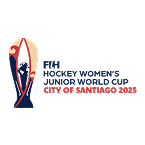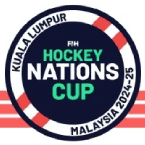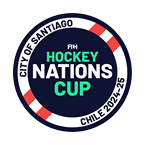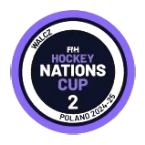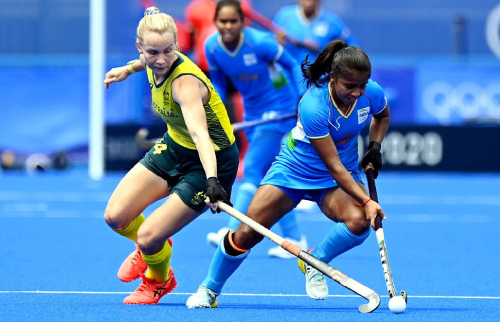
Sport Group, Polytan, and AstroTurf are at the forefront of innovations in dry hockey turf, so much so, that the FIH asked Paul Kamphuis, General Manager of Polytan Asia Pacific, to spearhead global discussions on the subject with federations worldwide.
In this role, Paul most recently presented the latest developments in dry turf and dry hockey at the FIH National Associations Summit at the Hockey5s World Cup in Oman.
As the most advanced turf manufacturer in the development of dry turf, he shares his extensive knowledge and experience here.
ON HIS ROLE IN THE DRY TURF PROCESS…
With two decades in hockey, I’ve been involved in the development of the Beijing, London, Rio, Tokyo and Paris Olympic turfs. Over the past four years, I've led Sport Group's dry turf initiatives, collaborating closely with the FIH.
ON THE HOCKEY5S WORLD CUP IN OMAN…
It was a great success. All the players I spoke with loved the format and it was certainly great to watch. There were over 900 goals scored, which is a goal every three to four minutes.
It was the first international ‘dry hockey’ event; it was played on a non-irrigated ‘Poligras Paris GT zero’ turf and the players adapted their skills, and in some cases, their footwear, to the dry surface.
It was such a success that in the future, all FIH Hockey5s events will be played on dry turf. This includes the 2026 Youth Olympic Games to be held in Dakar, Senegal.
ON THE ADVERSE PUBLICITY FOLLOWING OMAN…
From what I have seen, the few negative comments have been quite ill-informed and unhelpful to the development of dry hockey.
Oman featured teams from all continents and the event was a tremendous success. Sander de Wijn said he loved the event, and he has played 100+ games for the Netherlands so he knows a thing or two.
There were unfortunately some injuries, and as always there are lots of factors at play. It was probably the biggest range of athlete experience and fitness at an elite event that I have ever seen and Hockey5s is condensed and extremely intensive – so the stress on the players was significant. None of the players or the medical staff have attributed injuries to the turf being non-irrigated.
ON THE DECISION TO PLAY THE 2026 WORLD CUP ON AN IRRIGATED TURF…
During the Hockey5s World Cup in Oman, I had the privilege of presenting to the FIH Executive Board. Subsequently the FIH made a decision that the surface for the 2026 World Cup would be irrigated, and I think it was a good decision.
There are only two and half years until the 2026 World Cup. The new World Cup venue in Wavre, Belgium, requires the turf to be installed in October this year, so understandably, Belgium needed a definitive decision on whether or not to include an irrigation system in their construction.
As there have only been two Hockey5s events on dry turf to date, and no 11-a-side events, there has not been enough global testing with elite international players to commit to an 11-a-side World Cup.
There is also the practical reality, that between now and the World Cup, the teams would struggle to find dry turf venues on which to train. Certified dry turfs have special performance requirements, and playing elite dry hockey is not just a case of using existing water-based hockey pitches without irrigation.
ON DRY HOCKEY, NOT JUST DRY TURF…
The aim is to shift, not just to dry turf, but to dry hockey. Both Polytan and the FIH have always been consistent on this.
While we are advancing our Poligras turf technology as much as we can, it is more complex than just the turf. For dry hockey to fully develop, it will require innovations in sticks, balls, goalkeeper equipment, shoes, clothing, as well as adjustments in skills, tactics, and perhaps even the rules themselves. As a global hockey community, we need more than two years to achieve this.
ON THE TURF THAT WILL BE USED FOR THE 2026 WORLD CUP…
The World Cup will be played on the latest Poligras dry turf. It is just that the FIH has chosen to irrigate the turf to equalise performance and to make it fair for all teams.
During the dry turf learning process, hockey has discovered how water equalises the turf performance and moderates the surface temperature for player welfare and performance.
ON EQUALISING PERFORMANCE….
Equalising performance means keeping the surface the same for every participant, at each stage of the game. Hockey is not like cricket, tennis or golf where surface variations are a key part of the narrative of the game. For over 40 years, hockey has been trying to make the surface perfect for everyone, every time.
What we have discovered during the two Hockey5s test events, is that a dry turf plays differently depending on the time of the day, the temperature, atmospheric moisture and direct sunlight. This is essentially because, without water, the turf temperature increases and the hotter the turf gets, the softer the fibres become. This makes the turf feel heavier for the players as friction is increased. Water keeps the turf temperature consistent with the ambient temperature, and in general, keeps the turf cool.
On most occasions this will be fine. It will probably not matter if the turf properties change during a Saturday of club hockey. But a level playing field and consistency is paramount at a World Cup.
Take the example of the hosts playing in the evening. This is the norm. It is also when a dry turf is likely to play better, with more moisture likely to be present in the atmosphere. Other teams playing their games during the day, in hotter conditions, are likely to experience a drier turf which can feel heavier and increase player fatigue. This could have an unfair impact on how the tournament plays out.
ON DRY TURF AND PLAYER WELFARE…
Water moderates the surface temperature of a turf. In hot weather, with bright sunshine, a dry turf may heat up significantly through the middle of the day when the sun is at its highest. In connection, the risk of heat-related health and safety issues for players and officials increases, as is regularly seen with other sports such as tennis. Tennis sometimes postpones matches - is hockey prepared to do this? The tight match schedule in major international tournaments such as World Cups and Olympic Games would suggest that this would be problematic.
The 2026 World Cup will be played in the summer, what if there was heat wave like last summer? Could temperatures become dangerous for players and officials? Would it be acceptable for the organisers to irrigate the turf for player safety at the Amstelveen stadium where irrigation is already installed, but not at the new Wavre stadium? Similarly, teams playing matches in the early morning or evening would have a significant advantage over teams who have more matches scheduled in the hottest part of the day.
The only way hockey can understand the impact of this and decide if the sport is OK with the consequences, is by playing on dry turfs around the world in all climates. The World Cup is the pinnacle of hockey, and this is not the right event to be learning these impacts for the first time.
ON HOCKEY’S READINESS FOR CHANGE…
The shift to dry hockey will require leadership and perhaps legislation. The question is, how far is hockey willing to go? Will the top leagues in Europe allow, (or even require), their premium club competitions to be played on a dry turf? They could make that decision now.
It is also important not to lose sight of the fact that elite hockey represents less than 1% of hockey played globally. There could be a scenario where the top end will choose to play with reduced water for a variety of reasons. But the difference (and the real water saving), comes through the lower levels as a new generation of players emerge. Over time this will then drive further reduction in water usage at the elite level as a new generation of players come through who play on dry surfaces regularly.
ON WHAT’S NEXT FOR DRY HOCKEY…
Stepping back from the World Cup, there are many locations around the world that are embracing dry hockey. For example, we have just installed the first dry hockey turf in Africa at St Andrews School, South Africa and the early reports on its performance are extremely positive. St Andrews’ is the first turf in the world to be certified under the new FIH Dry Turf Hockey Field Innovation Category.
We are also installing a Poligras Paris GT zero turf in Namibia, where dry hockey will really make a difference. And Auckland Hockey in New Zealand are so happy with the performance of their Poligras Paris GT zero turf that they will shortly build a new two-turf facility without irrigation.
More testing of dry turf needs to happen around the world. In Northern Europe, where temperatures are cooler and there is plenty of rain, dry turf may well be an outstanding option for a club. But it might not be so good in the heat of Western Australia. I think we will find that there is dry turf, and then there is really DRY turf.
The good news is that our dry turf R&D has reduced the friction, which in turn, has significantly improved the performance of irrigated turf with a lot less water. All the feedback is that with reduced water, our Poligras Paris GT zero turf is playing incredibly well.
Our R&D focus remains on dry hockey. For elite hockey we are not at zero water yet, but we are trending significantly towards zero. And for us, any new turf needs to have green credentials and keep the traditional, texturized hockey surface look and feel. This is what delivers the multi-directional movement, control and 3D skills that the sport loves.
The Poligras Paris GT zero turf is a hit and shows that hockey supports sustainability. It has been installed in over 30 locations around the world. We are in touch with many of these venues to get feedback about the turf, wet and dry, in all weather conditions and with different levels of play. I also encourage the hockey community to visit a dry turf and try it firsthand. Only you can determine if it will suit your needs and your climate.
Poligras is available globally through Polytan in EMEA, Asia Pacific and Australasia, and AstroTurf in North and South America as well as our global installer network.


